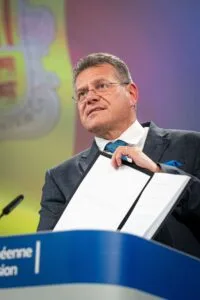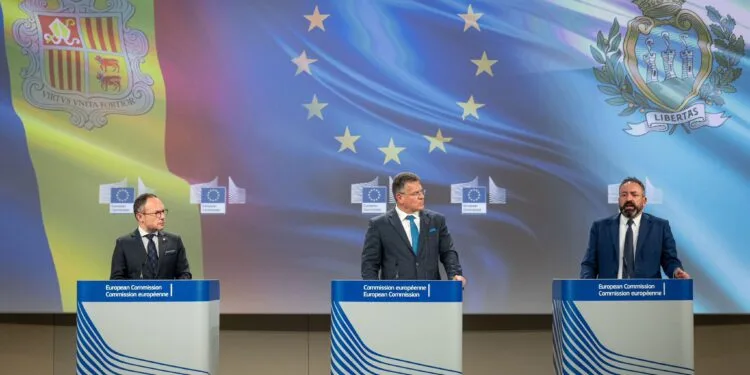Brussels – There is an agreement, and the understanding has been finalized. However, the entry into force of the European Union Association Agreement with San Marino and Andorra still requires some formal steps. The von der Leyen Cabinet hopes to seal them “by the end of the year at the latest.” Providing an outline timeline in the aftermath of the finalization of the “300-page text” was the EU Commission’s executive vice-president responsible for inter-institutional relations, Maroš Šefčovič, who at a press conference yesterday afternoon (May 7) put the finishing touches to the work on filing the legal texts, paving the way for final approval by the EU institutions and the two European microstates.

“We are starting the procedure in the Council with the translation and the discussion. We expect the Council to authorize us to sign the Association Agreement in the late fall,” Šefčovič explained alongside Andorra’s prime minister, Xavier Espot, and San Marino’s foreign affairs minister, Luca Beccari. There remains a veil of uncertainty, however, as to the date by which the negotiating path that began in March 2015 will be finally concluded, given the fact that the composition of the institutions charged with closing the process will be almost entirely different from the one that reached the historical understanding in December 2023. Both the EU and San Marino will hold elections in June, which means that two out of three players (Andorra held them last year) will have new parliaments–in charge of ratifying the agreement–and new executives, as well as a new six-month presidency of the EU Council (from July 1). “The incoming Hungarian presidency is also interested in rapid progress,” Šefčovič was keen to reassure.
Speaking of what is at stake, on December 12, 2023, the three parties communicated the outcome of over eight years of negotiations, with all the details of an agreement comparable to the one that regulates relations between Brussels and Norway, Iceland, and Liechtenstein. “We have probably gone further. It is the most far-reaching agreement that the European Union has, a kind of European Economic Area +,” the vice president of the EU Commission exulted. The agreement provides for the participation of San Marino and Andorra in the EU Internal Market on a level playing field, including financial services, but in a progressive manner and depending on the outcome of the verification of the soundness of regulatory and supervisory frameworks (the precondition is compliance with anti-money laundering measures). In parallel, a development framework will be established for dialogue and cooperation in areas of common interest – research and development, education, social policy, environment, consumer protection, culture, or regional cooperation – and an institutional one for the interpretation and application of the agreement in line with European jurisprudence (of which the EU Court of Justice is the final arbiter for disputes).
Association Agreement negotiations began in March 2015, but the aftermath of the Russian war in Ukraine triggered an acceleration: on June 30, 2022, a roadmap to sign by 2024 the Association Agreements with Andorra, Monaco, and San Marino was submitted. However, in late August 2023, the Presidents of the European Banking Authority (EBA), the European Securities and Markets Authority (ESMA), and the European Insurance and Occupational Pensions Authority (EIOPA) warned the Commission that finalizing these agreements could open the doors of the Single Market to a destabilization of financial services. Within two weeks, the advisor to the Ministry of Foreign Affairs and Cooperation of the Principality of Monaco, Isabelle Berro-Amadei, agreed with Ursula von der Leyen‘s right-hand man that “the conditions were not ripe to conclude an agreement.” Work thus continued only with San Marino and Andorra.
San Marino, Andorra, and the other European microstates
To date, the two European microstates in question have different statuses. Neither San Marino nor Andorra is part of the Schengen area (which provides for the free movement of people between EU member states and the abolition of common borders). However, there has been a customs union with the Union since 1991: for San Marino alone, there has been a union for agricultural products since 2002. Andorra maintains part of its border controls only at some border crossings with Spain. As for the Principality of Monaco – which took a step back from the Association Agreement in September 2023 – there is currently a hybrid situation, applying some EU policies through the special relationship it has with France: it is a de facto member of Schengen, while it is part of the customs territory of the Union.
As for other European microstates, Liechtenstein is the only one to be part of the European Economic Area and the Single Market (since May 1, 1995), and signed the Schengen agreements on December 19, 2011. The Vatican City is the smallest recognized state in the world and has only an open border with Italy. All European microstates (except Liechtenstein, which uses the Swiss franc) use the euro as their official currency and have the right to mint a limited amount because they used or were linked to currencies no longer in circulation in some member countries (lira for San Marino and Vatican City, French franc for Monaco, Spanish peseta and French franc for Andorra). Brussels has no interest in integrating any of the European microstates as a member country since it would be excessively complex to manage internal EU issues (such as rotating presidencies of the EU Council or member states’ right of veto) for territorial entities that are too limited in area and population.
English version by the Translation Service of Withub



